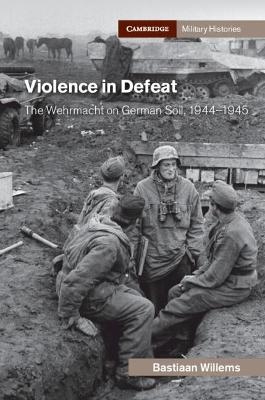
Violence in Defeat
The Wehrmacht on German Soil, 1944–1945
Seiten
2021
Cambridge University Press (Verlag)
978-1-108-47972-1 (ISBN)
Cambridge University Press (Verlag)
978-1-108-47972-1 (ISBN)
Explores the diverse intra-ethnic violence that gripped the country in the months prior to Germany's defeat, and examines the interplay between the Wehrmacht and the Nazi Party to shed important new light on the roles both played in shaping German society at the end of the war.
In the final year of the Second World War, as bitter defensive fighting moved to German soil, a wave of intra-ethnic violence engulfed the country. Bastiaan Willems offers the first study into the impact and behaviour of the Wehrmacht on its own territory, focusing on the German units fighting in East Prussia and its capital Königsberg. He shows that the Wehrmacht's retreat into Germany, after three years of brutal fighting on the Eastern Front, contributed significantly to the spike of violence which occurred throughout the country immediately prior to defeat. Soldiers arriving with an ingrained barbarised mindset, developed on the Eastern Front, shaped the immediate environment of the area of operations, and of Nazi Germany as a whole. Willems establishes how the norms of the Wehrmacht as a retreating army impacted behavioural patterns on the home front, arguing that its presence increased the propensity to carry out violence in Germany.
In the final year of the Second World War, as bitter defensive fighting moved to German soil, a wave of intra-ethnic violence engulfed the country. Bastiaan Willems offers the first study into the impact and behaviour of the Wehrmacht on its own territory, focusing on the German units fighting in East Prussia and its capital Königsberg. He shows that the Wehrmacht's retreat into Germany, after three years of brutal fighting on the Eastern Front, contributed significantly to the spike of violence which occurred throughout the country immediately prior to defeat. Soldiers arriving with an ingrained barbarised mindset, developed on the Eastern Front, shaped the immediate environment of the area of operations, and of Nazi Germany as a whole. Willems establishes how the norms of the Wehrmacht as a retreating army impacted behavioural patterns on the home front, arguing that its presence increased the propensity to carry out violence in Germany.
Bastiaan Willems is a Postdoctoral Research Fellow of Modern European History at University College London.
List of Figures; List of Maps; List of Tables; Acknowledgements; Chronology; List of Abbreviations; Introduction; 1. Regionality and Total War in East Prussia; 2. Eastern Front Battles on German Soil; 3. The City as a Fortress-Community; 4. Redefining Königsberg: Historical Continuity in Practice; 5. The Evacuation of East Prussia; 6. Königsberg as a Community of Violence; Conclusion; Appendices; Bibliography; Index.
| Erscheinungsdatum | 24.02.2021 |
|---|---|
| Reihe/Serie | Cambridge Military Histories |
| Zusatzinfo | Worked examples or Exercises |
| Verlagsort | Cambridge |
| Sprache | englisch |
| Maße | 160 x 235 mm |
| Gewicht | 650 g |
| Themenwelt | Geschichte ► Allgemeine Geschichte ► 1918 bis 1945 |
| Geschichte ► Teilgebiete der Geschichte ► Militärgeschichte | |
| ISBN-10 | 1-108-47972-3 / 1108479723 |
| ISBN-13 | 978-1-108-47972-1 / 9781108479721 |
| Zustand | Neuware |
| Informationen gemäß Produktsicherheitsverordnung (GPSR) | |
| Haben Sie eine Frage zum Produkt? |
Mehr entdecken
aus dem Bereich
aus dem Bereich
ein Psychologe erlebt das Konzentrationslager
Buch | Hardcover (2024)
Kösel (Verlag)
CHF 30,80
Mythos „Stauffenberg-Attentat“ – wie der 20. Juli 1944 verklärt und …
Buch | Hardcover (2024)
Goldmann (Verlag)
CHF 33,55


